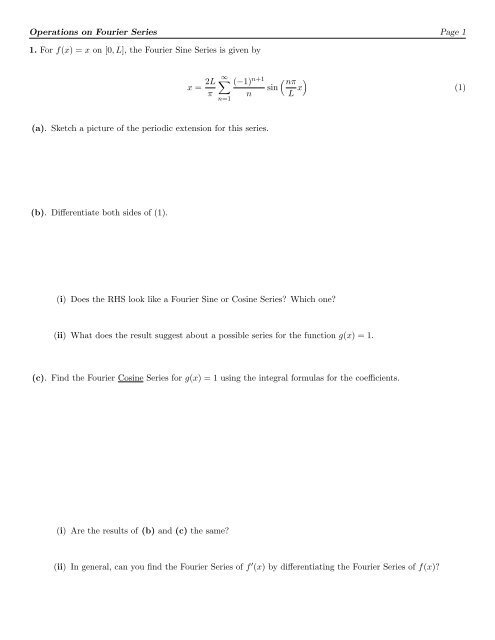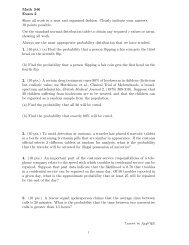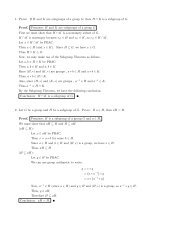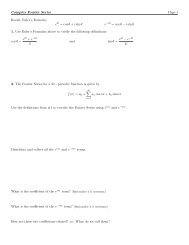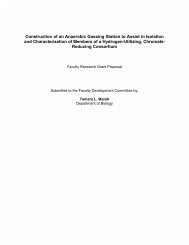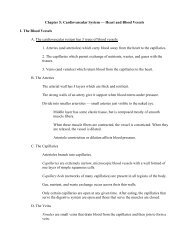Operations on Fourier Series Worksheet
Operations on Fourier Series Worksheet
Operations on Fourier Series Worksheet
You also want an ePaper? Increase the reach of your titles
YUMPU automatically turns print PDFs into web optimized ePapers that Google loves.
<str<strong>on</strong>g>Operati<strong>on</strong>s</str<strong>on</strong>g> <strong>on</strong> <strong>Fourier</strong> <strong>Series</strong> Page 1<br />
1. For f(x) = x <strong>on</strong> [0, L], the <strong>Fourier</strong> Sine <strong>Series</strong> is given by<br />
x = 2L<br />
π<br />
∞ (−1) n+1<br />
n=1<br />
(a). Sketch a picture of the periodic extensi<strong>on</strong> for this series.<br />
(b). Differentiate both sides of (1).<br />
n<br />
<br />
nπ<br />
sin<br />
L x<br />
<br />
(i) Does the RHS look like a <strong>Fourier</strong> Sine or Cosine <strong>Series</strong>? Which <strong>on</strong>e?<br />
(ii) What does the result suggest about a possible series for the functi<strong>on</strong> g(x) = 1.<br />
(c). Find the <strong>Fourier</strong> Cosine <strong>Series</strong> for g(x) = 1 using the integral formulas for the coefficients.<br />
(i) Are the results of (b) and (c) the same?<br />
(ii) In general, can you find the <strong>Fourier</strong> <strong>Series</strong> of f ′ (x) by differentiating the <strong>Fourier</strong> <strong>Series</strong> of f(x)?<br />
(1)
<str<strong>on</strong>g>Operati<strong>on</strong>s</str<strong>on</strong>g> <strong>on</strong> <strong>Fourier</strong> <strong>Series</strong> Page 2<br />
2. For f(x) = x <strong>on</strong> [0, L], the <strong>Fourier</strong> Cosine <strong>Series</strong> is given by<br />
x = L + 2L<br />
π 2<br />
∞ −1 + (−1) n<br />
n=1<br />
(a). Sketch a picture of the periodic extensi<strong>on</strong> for this series.<br />
(b). Differentiate both sides of (1).<br />
n 2<br />
<br />
nπ<br />
cos<br />
L x<br />
<br />
(i) Does the RHS look like a <strong>Fourier</strong> Sine or Cosine <strong>Series</strong>? Which <strong>on</strong>e?<br />
(ii) What does the result suggest about a possible series for the functi<strong>on</strong> g(x) = 1.<br />
(c). Find the <strong>Fourier</strong> Sine <strong>Series</strong> for g(x) = 1 using the integral formulas for the coefficients.<br />
(i) Are the results of (b) and (c) the same?<br />
(ii) Hmm... why did it work this time?<br />
(2)
<str<strong>on</strong>g>Operati<strong>on</strong>s</str<strong>on</strong>g> <strong>on</strong> <strong>Fourier</strong> <strong>Series</strong> Page 3<br />
3. Look at the periodic extensi<strong>on</strong> you sketched in (1a) and (2a). What significant difference (besides odd vs.<br />
even) do you notice about the two different extensi<strong>on</strong>s?<br />
Use this observati<strong>on</strong> to fill in the blank in the following Theorem:<br />
Theorem<br />
If f(x) is periodic, c<strong>on</strong>tinuous , and piecewise smooth, then the differentiated <strong>Fourier</strong> <strong>Series</strong> of f(x)<br />
c<strong>on</strong>verges to f ′ (x) at every point x where f ′′ (x) exists.<br />
i.e. If f(x) satisfies those c<strong>on</strong>diti<strong>on</strong>s and<br />
f(x) = a0 +<br />
f ′ (x) = a0 +<br />
∞<br />
n=1<br />
∞<br />
n=1<br />
<br />
nπ<br />
an cos<br />
L x<br />
<br />
nπ<br />
+ bn sin<br />
L x<br />
<br />
then<br />
<br />
nπ<br />
an cos<br />
L x<br />
<br />
<br />
nπ<br />
+ bn sin<br />
L x<br />
<br />
4. Look up Theorem 3 <strong>on</strong> p. 85 and fill in the blank below:<br />
Theorem<br />
If f(x) is periodic and piecewise c<strong>on</strong>tinuous then the <strong>Fourier</strong> <strong>Series</strong> of f(x) may be integrated term by<br />
term and will equal the integral of f(x).<br />
How do the requirements for f(x) differ for integrati<strong>on</strong> versus differentiati<strong>on</strong>? Which <strong>on</strong>e has stricter requirements?<br />
5. The <strong>Fourier</strong> Sine <strong>Series</strong> for f(x) = 1 <strong>on</strong> [0, L] is given by<br />
1 = 4<br />
π<br />
∞<br />
n=1<br />
1<br />
2n − 1 sin<br />
<br />
(2n − 1)π<br />
x<br />
L<br />
(a). Change the variable to t and then integrate both sides of (3) with respect to t from 0 to x.<br />
You should get a sum of terms involving cosines of “x-stuff” and a separate sum involving just c<strong>on</strong>stants. You may need to<br />
distribute and split up the sum.<br />
(3)
<str<strong>on</strong>g>Operati<strong>on</strong>s</str<strong>on</strong>g> <strong>on</strong> <strong>Fourier</strong> <strong>Series</strong> Page 4<br />
(b). The result of part(a) is the <strong>Fourier</strong> Cosine <strong>Series</strong> for which functi<strong>on</strong>?<br />
(c). What does the general form for a <strong>Fourier</strong> Cosine <strong>Series</strong> look like?<br />
(d). How does this compare with your result in part (a)? Based <strong>on</strong> the result from part (a), what does the<br />
coefficient A0 equal?<br />
(e). Use the integral formula and the functi<strong>on</strong> from part (b) to find the coeffcient A0.<br />
(f). Since both parts (d) and (e) give valid answers for the coefficient A0, they should be equal. Set them equal<br />
and solve for the summati<strong>on</strong> <strong>on</strong>ly.<br />
(g). Woo Hoo!! We just found the sum of what series?
<str<strong>on</strong>g>Operati<strong>on</strong>s</str<strong>on</strong>g> <strong>on</strong> <strong>Fourier</strong> <strong>Series</strong> Page 5<br />
6. Your result of integrating the <strong>Fourier</strong> <strong>Series</strong> for f(x) = 1 should have given you: [Using the simpler versi<strong>on</strong> of A0.]<br />
x = L<br />
2<br />
− 4L<br />
π 2<br />
∞<br />
n=1<br />
<br />
1 (2n − 1)π<br />
cos<br />
x<br />
(2n − 1) 2 L<br />
(a). Integrate both sides again with respect to x [You can take the integrati<strong>on</strong> c<strong>on</strong>stant(s) to be 0].<br />
(b). Is the result a <strong>Fourier</strong> <strong>Series</strong>? Why or why not?<br />
(c). What is the <strong>Fourier</strong> Sine <strong>Series</strong> for h(x) = 1<br />
2 x2 − L<br />
2 x?<br />
Homework:<br />
• Read Secti<strong>on</strong> 1.5. For each theorem 1-6, state the theorem and then explain it in your own words.<br />
• Secti<strong>on</strong> 1.5, p. 89: #1, 2, 5, 9, 10


